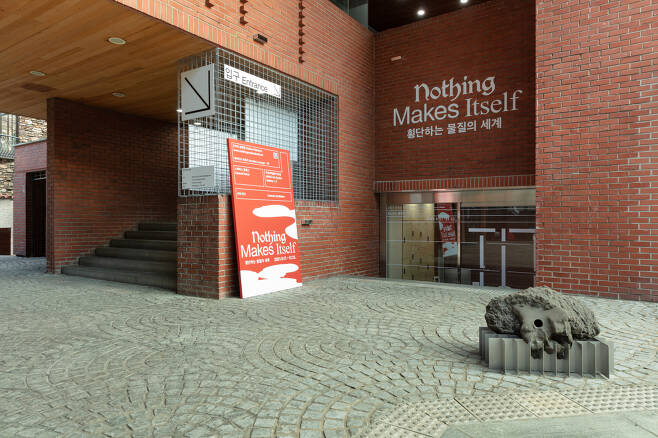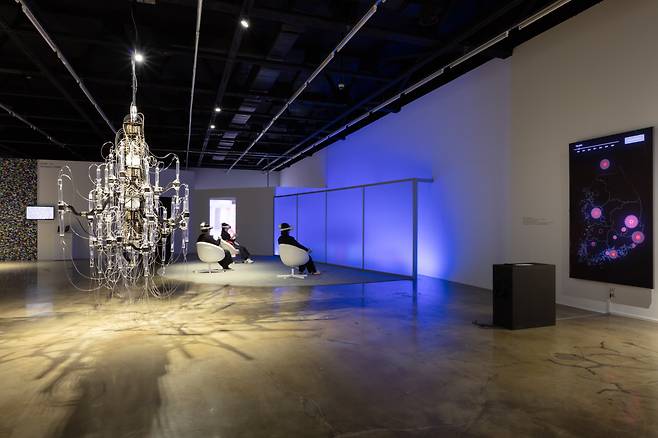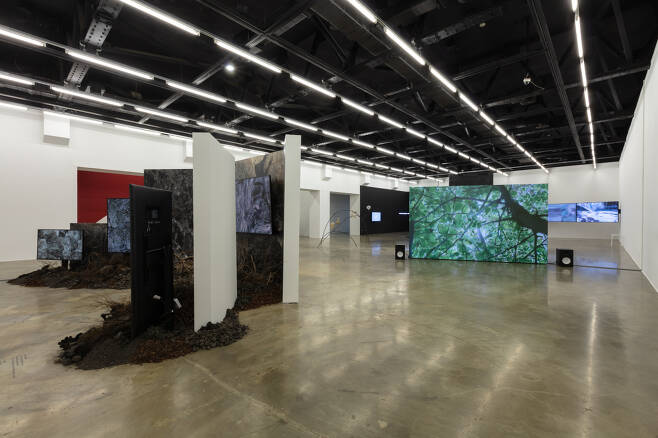Arko Art Center brings together artists who envision future world
이 글자크기로 변경됩니다.
(예시) 가장 빠른 뉴스가 있고 다양한 정보, 쌍방향 소통이 숨쉬는 다음뉴스를 만나보세요. 다음뉴스는 국내외 주요이슈와 실시간 속보, 문화생활 및 다양한 분야의 뉴스를 입체적으로 전달하고 있습니다.

The Arko Art Center, a museum in central Seoul, kicked off “Nothing Makes Itself” to explore interaction and interconnection with nonhuman entities and pose the question of how humans can mingle with technology and nature.
The installation work “Impulse” hangs from the ceiling as if it were a chandelier. It ceaselessly transmits clear liquid and bubbles into the transparent cylinders to its 27 branches. Some may see it as an upside down tree whose pure sap flows to its branches without pulsation.
“It shows the fluidity of things,” installation artist Kim Yun-chul said during the press opening Sept. 17. Kim will participate in the 59th Venice Biennale in April 2022 and present his works at the South Korean pavilion.

The large-scale exhibition involves 35 artists from home and abroad whose 50 multidisciplinary artworks rely on science and technology: virtual reality, augmented reality, 3D printing, robotics and data visualization.
The concept of “trans-corporeality” dominates the exhibition, which redefines the relationships among humans, technology and the environment, breaking away from human-imposed dichotomies. The term “trans-corporeality” was coined by American literary scholar and eco-cultural theorist Stacy Alaimo.
Danish artist Sissel Marie Tonn raises awareness about how plastic pollution crisscrosses the marine and terrestrial realms. Her media artwork “Becoming a Sentinel Species” follows two researchers who experimentally introduce microplastics collected from the sea into their own bodies.
"The human health impacts of microplastics are yet to be elucidated, but their presence in our bodies and surroundings is a potent reminder that we are not impenetrable entities, but rather fluid organisms,” the artist says on film.

The artists demonstrate how closely humans and the environment are related and look at the voices of diverse lives and communities. They visualize the links between the invisible environmental elements and humans or envisage humans living in a hypothetical future environment resulting from climate change.
The exhibition runs through Dec. 12. The final week of the exhibition will feature film screenings in line with the exhibition themes provided by the Green Archive of the Seoul Eco Film Festival. During the exhibition, the museum will also offer international symposiums and talks among artists, experts and audiences from different backgrounds and regions to expand the discussion around the exhibition.

Founded in 1974, the Arko Art Center is run by Arts Council Korea. The museum is closed Mondays, and online reservations through Naver are required to visit the exhibition.
By Park Yuna (yunapark@heraldcorp.com)
By Park Yuna(yunapark@heraldcorp.com)
Copyright © 코리아헤럴드. 무단전재 및 재배포 금지.